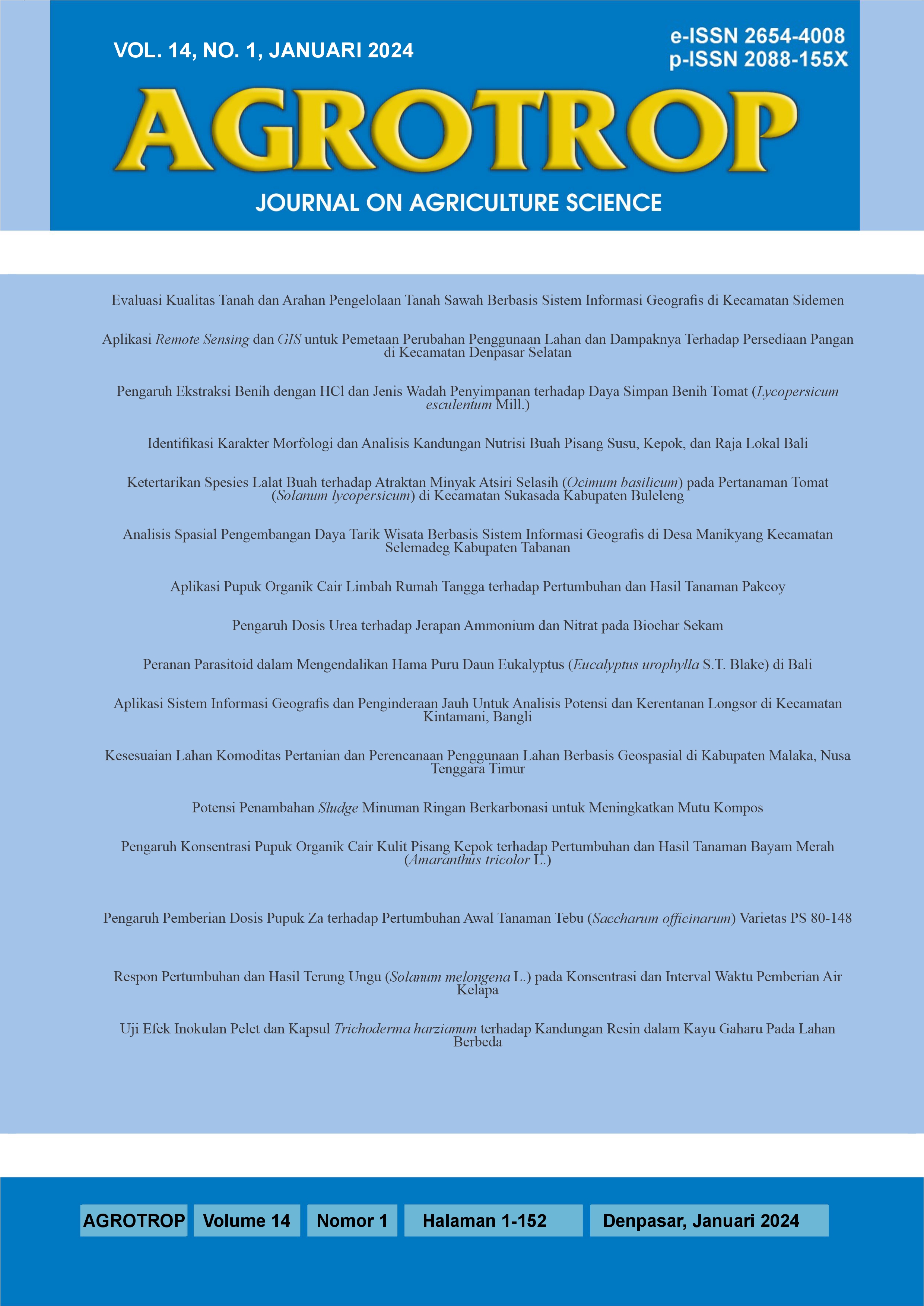Evaluasi Kualitas Tanah dan Arahan Pengelolaan Tanah Sawah Berbasis Sistem Informasi Geografis di Kecamatan Sidemen
Abstract
Evaluation of Soil Quality and Directions for Paddy Field Management Based on Geographic Information Systems in Sidemen District. Soil quality assessment is a crucial component of agricultural land management, as it provides valuable information about the condition of soil and its limiting factors, which in turn influences crop productivity and sustainability. Understanding the quality of soil is essential for making informed decisions related to land management practices, such as fertilization, irrigation, and crop rotation, to optimize agricultural production and protect the environment. The research was conducted in agricultural lands Sidemen District, Bali Province. The aim of the study was to analyse the physical, chemical, and biological factors to evaluate the spatial distribution of soil quality. Method for this research is integrated for Geographic Information System, field survey, laboratory soil analysis, and quantification soil quality based on Lal (1994). Soil quality indicators, such as soil texture, unit weight, porosity, moisture content, field capacity, pH, C-organic, CEC, base saturation, nutrients (N, P, and K), and C-biomass, were measured as a minimum data set (MDS). This study showed that the soil quality have a moderate to good category. The limiting factors in the study area encompassed texture, water content, N, P, and C-biomass. The proposed land management recommendations include utilizing tractors and implementing organic fertilizers, urea, and SP-36 in the paddy fields of the Sidemen District.
Downloads
References
Bhayunagiri, I. B.P, & M. Saifulloh, (2022). Mapping Of Subak Areaboundaries And Soil Fertility For Agriculturalland Conservation. Geographia Technica, 17(2).
BPS Karangasem. 2020. Kecamatan Sidemen Dalam Angka 2020. Badan Pusat Statistik Kabupaten Karangasem.
Darmawijaya, M. I. 1990. Klasifikasi Tanah. Penerbit Universitas Gajah Mada. Yogyakarta.
Dharma, I. P., & I. N. Puja,. (2019). Pengaruh Frekuensi pengolahan Tanah dan pupuk Kompos Terhadap Sifat Fisik Tanah Dan Hasil Jagung. Agrotrop : Journal on Agriculture Science, 9(2), 154.
Diara, I. W., R Suyarto, & M Saifulloh..2022. Spatial Distribution Of Landslide Susceptibility In New Road Construction Mengwitani-Singaraja, Bali-Indonesia: Based On Geospatial Data. Geomate Journal, 23(96), 95-103.
Dibia, I. N. 2015. Evaluasi Kesesuaian Lahan untuk Pengembangan Tanaman Kayu Putih (Malaleuca leucadendra) pada Kawasan Hutan Produksi Bali Barat (Kecamatan Grokgak) Kabupaten Buleleng Bali. Agrotrop, 5(2), 194–205.
Hanafiah, K.A, 2008. Dasar-Dasar Ilmu Tanah. Jakarta : PT. Raja Grafindo Persada.
Kartasapoetra, A. G., G. Kartasapoetra dan M. M. Sutedjo. 1991. Tehnologi Konservasi Tanah Dan Air. Rineksa Cipta. Jakarta.
Kartini, N. L., M. Saifulloh,., N. M. Trigunasih,., & I. W. Narka,. 2023. Assessment of Soil Degradation Based On Soil Properties and Spatial Analysis in Dryland Farming. Journal of Ecological Engineering, 24(4), 368-375.
Lal, R. 1994. Method and Guidelines for Assesing Suistainable Use for Soil and Water Resources in The Tropics. SMSS Tech. Monograph No. (21). USDA. 78 hal.
Rasyid, B. 2004. Kualitas Tanah (Soil Quality). Lembaga penerbitan Universitas Hasanuddin Makassar. Sulawesi Selatan.
Reintjes, C., B. Haverkot, dan A.W. Bayer. 1999. Pertanian Masa Depan. ILEIA. Kanisius, Yogjakarta.
Soniari, N. N., & I. W. D. Atmaja,. 2019. Isolation and identification of Azotobacter of some type of land use in Jegu villages. International Journal of Biosciences and Biotechnology, 6(2), 106-113.
Tangketasik, A., N. M Wikarniti,., N. N Soniari,., & I. W. Narka,. 2012. Kadar Bahan Organik Tanah pada Tanah Sawah dan Tegalan di Bali serta Hubungannya dengan Tekstur Tanah. Agrotrop, 2(2), 101–107.
Trigunasih, N. M., & M. Saifulloh. (2022a). The Investigating Water Infiltration Conditions Caused by Annual Urban Flooding Using Integrated Remote Sensing and Geographic Information Systems. Journal of Environmental Management & Tourism, 13(5), 1467-1480.
Trigunasih, N. M., & M. Saifulloh,. (2022b). Correlation between soil nitrogen content and NDVI derived from sentinel-2A satellite imagery. Jurnal Lahan Suboptimal: Journal of Suboptimal Lands, 11(2), 112-119.
Trigunasih, N.M., & M. Saifulloh.. (2022c). Spatial Distribution of Landslide Potential and Soil Fertility: A Case Study in Baturiti District, Tabanan, Bali, Indonesia. Journal of Hunan University Natural Sciences, 49(2).
Trigunasih, N. M., & M. Saifulloh. 2023. Investigation Of Soil Erosion In Agro-Tourism Area: Guideline For Environmental Conservation Planning. Geographia Technica, 18(1), 19.
Wiyanti, W., K. D. Susila., , R. Suyarto, & M. Saifulloh. 2022. Analisis Spasial Potensi Resapan Air Untuk Mendukung Pengelolaan Daerah Aliran Sungai (Das) Unda Provinsi Bali (Spatial Analysis of Water Infiltration Potential to Support The Management of Unda Watershed in Bali Province). Jurnal Penelitian Pengelolaan Daerah Aliran Sungai (Journal of Watershed Management Research), 6(2), 111-124.
Wenas, D., A. Supadma,. & I. Arthagama, 2023. Evaluasi Kualitas Tanah Berbasis Sistem Infromasi Geografis di Lahan Sawah Kecamatan Denpasar Timur untuk Menentukan Arahan Pengelolaan. Agrotrop : Journal On Agriculture Science, 13(1), 1-12. doi:10.24843/AJoAS.2023.v13.i01.p01











